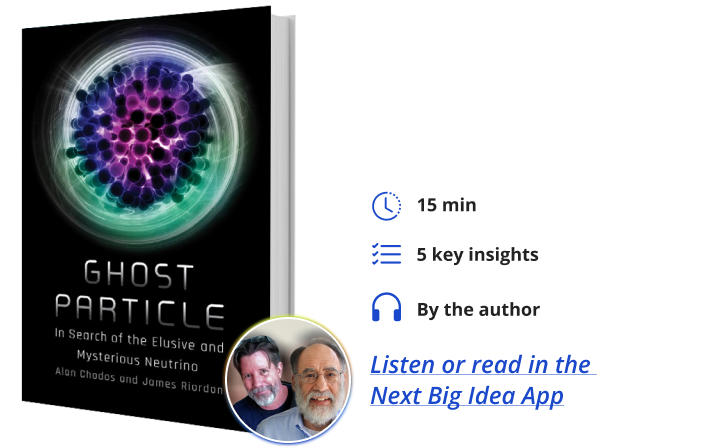Alan Chodos received his undergraduate degree in physics from McGill University, and his Ph.D. in theoretical physics from Cornell University. After postdoctoral appointments at the University of Pennsylvania and MIT, he spent 24 years doing research in physics and teaching at Yale.
James Riordon is a science journalist who covers physics, math, astronomy, chemistry and occasional lifestyle stories. His articles have appeared in Science News Magazine, Quanta Magazine, Scientific American, New Scientist, and The Washington Post.
Below, James and Alan share 5 key insights from their new book, Ghost Particle: In Search of the Elusive and Mysterious Neutrino. Listen to the audio version—read by James—in the Next Big Idea App.

1. Neutrinos are literally everywhere.
The sun puts out so many neutrinos that 100 trillion of them fly through you every second of your life. But even all those solar neutrinos are nothing compared to the ones that are the oldest particles in the cosmos. These ancient neutrinos are relics of the Big Bang that started it all. They spewed forth in the first few millionths of a second after the universe began and they’ve been around ever since. At any instant, you have around three hundred Big Bang relic neutrinos in the tip of your pinky finger alone, and another 15 million or so in the rest of you. Altogether, there are more of them in the universe than any other particle, besides the bits of light we call photons.
Despite all these neutrinos flooding your body, you’ll almost certainly never realize it. A typical solar neutrino could pass through trillions of miles of lead more easily than light shines through a windowpane. You’re almost completely transparent to them. Chances are, in your entire lifetime, one or two neutrinos will hit an atom inside you and convert it to a different type of atom. Even then, you’d probably notice nothing at all but, that doesn’t mean neutrinos aren’t important.
2. Neutrinos may be the reason we exist.
We shouldn’t be here—in fact, nothing should be. When the Big Bang happened, it made a lot of matter, but it also made exactly the same amount of antimatter. When matter and antimatter get together, they annihilate each other. So, you might expect there to be nothing left over after all, being that matter and antimatter from the Big Bang wiped each other out. Yet, here we are, in a world filled with plain old matter, with no antimatter in sight. New experiments are looking to neutrinos to help us understand where all the antimatter went, and why matter—and we—are still around.
“When matter and antimatter get together, they annihilate each other.”
Scientists hope to catch antimatter neutrinos turning into their matter version, and vice versa. If those experiments are successful, they’ll explain why anything exists in the universe at all, and how neutrinos were key to making that happen, and to making you and me possible.
3. Neutrinos are weird.
There are particles that we know exist, and that we know lots about: electrons, photons, and quarks are a few. Then there are particles that we aren’t sure exist and we know very little about, like the bits that might make up dark matter or the gravitons that could explain where gravity comes from. Neutrinos are the only particles that we know for sure exist, but that we know surprisingly little about. The first weird thing about them is that neutrinos come in at least three types, known as flavors. Unlike any other particle, they change their identities—perpetually shifting from one flavor to another.
That weird flavor change threw our understanding of neutrinos into a tizzy. Physicists had assumed neutrinos were massless, like photons. The fact that flavors change, though, means that they have at least some mass, but we don’t know how much. Even now, we aren’t sure that the three flavors we’ve found so far are all there are. There may be one more, or maybe six, or perhaps many more that we just haven’t found yet. Neutrinos may even break the ultimate speed limit in the universe—the speed of light. They probably don’t, but we can’t say for sure yet. If they do, that would be the weirdest thing about them of all.
4. Neutrinos offer a unique window into the cosmos.
There are things in the universe that only neutrinos can show us. Physicists will soon use neutrino detectors to image the interior of the Earth to its very core in ways that geologists can only dream of. Neutrinos can also let us look inside some of the most violent and beautiful events in the universe. The flash of neutrinos that comes when stars explode into supernovas is the only way to trace the death throes of stars. The burst of neutrinos they emit as they die will give us an early warning before the next nearby supernova lights up the sky. It will be the astronomical display of a lifetime. Neutrinos will tell us when a supernova is coming and where you should look in the sky to see it.
“Physicists will soon use neutrino detectors to image the interior of the Earth to its very core in ways that geologists can only dream of.”
Remember all those relic neutrinos, the ones in the tip of your pinky finger? Those relics are links to the very beginning of time. We don’t have a good way to study them right now but, eventually, they will offer up exclusive baby pictures of the universe, as seen through neutrino telescopes. Nothing else can give us a peek into those places, now or ever. It takes neutrinos.
5. As weird as they are, neutrinos are useful.
There’s no way to stop neutrinos from coming out of nuclear reactors. If someone uses a reactor to illegally make nuclear weapons, we’ll be able to tell by looking for the neutrinos the reactor produces. Then there are neutrino communications: If you want to send a message to the other side of the planet, the signal that carries it will have to go around the Earth—unless you use neutrinos. Neutrinos are the only things that we could shoot straight through the planet and then catch on the other side. Scientists have already tested the concept by using a neutrino beam to send a message through ten kilometers of solid rock.
If aliens wanted to chat with us from distant parts of the universe, neutrinos could very well be the best way to do it. Light and radio waves get distorted and scattered by space dust and anything else along the way. However, a beam of neutrinos could make the trip through millions of lightyears of dust, planets, and even stars, to carry messages. We don’t have the machines to send neutrino messages to distant planets, at the moment. However, we could already receive signals from aliens with the detectors we have now if they decided to get in touch.
Neutrino applications like these are still speculative, and there’s a lot left to learn about neutrinos themselves. We’ve come a long way since the neutrino was a terrible thing that perplexed and confused us; it’s now a critical piece in our understanding of the elements, the stars, and the universe. Neutrinos remain the most mysterious particles we know of; however, solutions to many neutrino puzzles look imminent. When we find them, they will help us to answer some of the deepest questions in science. They will tell us how the universe came to be in the first place, why it looks the way it does, and why we’re in it today.
To listen to the audio version read by co-author James Riordon, download the Next Big Idea App today:






























